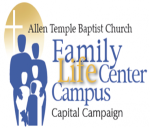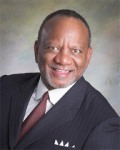Prayer must be at the heart of church fundraising, but the fundamentals of fundraising also contribute to success. We met Willis White when he was serving as co-chair for a $3.5 million, multi-year campaign to retire the debt on the Allen Temple Baptist Church Family Life Center. We worked with White, his co-chair Constance Walker and the church’s campaign leadership team during their campaign.
The campaign was the vision of the senior pastor who called on White and Walker to serve as co-chairs. White had been prayerful regarding a ministry when he was approached by his pastor. “It felt like a calling to serve. Our pastor was respected by everyone and had served the church for over 40 years. It was an honor to be asked.”
White attributes the campaign’s success to prayer and planning. “We allowed the Lord to lead us, to lead the membership. All the gifts and donations we received are because the Lord made a way for us. We prayed and we planned. We hired fundraising counsel to help us. That was critical. It was one of the key reasons I accepted the request to serve as a co-chair.”
 “Working with counsel we laid out a plan that would take us through the full campaign. Because the plan was in writing we could meet with people who had agreed to help with the campaign and talk with them about what we needed to do. The plan was key to galvanizing our membership. It had two components – an internal effort and an external community effort. The church membership bought into the idea of raising money to show our own commitment to the campaign before raising money from outside the church.”
“Working with counsel we laid out a plan that would take us through the full campaign. Because the plan was in writing we could meet with people who had agreed to help with the campaign and talk with them about what we needed to do. The plan was key to galvanizing our membership. It had two components – an internal effort and an external community effort. The church membership bought into the idea of raising money to show our own commitment to the campaign before raising money from outside the church.”
Working with the culture of church, the membership organized itself into groups that corresponded to the 12 tribes of Israel and the 12 months of the year. “This allowed everyone to be a part of the campaign: you were a part of the campaign because you were part of a tribe because of your birth month.
The campaign’s naming opportunities motivated giving by individuals, families, and by groups and organizations from within the church. “These opportunities encouraged giving even though people were dealing with the downturn in the economy. For example, the ministers got together and pooled their gifts towards a naming opportunity to honor the outstanding work of one of our ministers. We had a $50,000 naming opportunity for the stage and the music department pooled their gifts, naming the stage in honor of our music director. Naming of the windows was a motivator – people used that opportunity to honor their loved ones or family. People were proud to show that they gave to the campaign and to show their commitment to the church.
The power of faith and planning
Motivation, prayer, faith and teamwork were key to White’s experience.
“Our campaign leadership committee had to stay motivated and we had to motivate the congregation. We had awareness Sunday on the first Sunday of each month where we reported on the progress of the campaign. People would rally around; it reminded people the campaign was going on, and motivated them to participate. Our strength came from faith and prayer. We were always amazed by the success we would have from month-to-month. We were making payments of $50,000 a quarter for debt service during difficult economic times; that was amazing.
Faith, prayer and planning are at the core of the advice he offers to church leaders who are considering a campaign. “Number one: be prayerful. You will be successful because of your faith. But make sure you give God all the glory for your success. Number two: work from a plan. Number three: consider a co-chair approach. It gave us continuity and constant leadership. When something came up for one person there was always a co-chair there who knew what was going on and could keep things going. We used that approach with the tribes as well. This is helpful because in a church there are usually a small number of people who do much of the work. Having a co-chair took some of the pressure off of the leaders and created support. In our church there is always the same group of individuals who volunteer to serve in the auxiliaries, and the co-chair approach shared the leadership responsibilities.
We asked how he sustained his commitment throughout the campaign. “Faith. It was always exciting and always rewarding to be able to raise money and to make $50,000 payments towards our debt. We wouldn’t know in the beginning of the quarter where the money would come from and to see the money appear in time to make the payment was very motivating. We felt the Lord blessed us every quarter to make these payments. It increased the faith of our membership – people continued to be amazed about what we as membership could do. We knew that continuous work and continuous prayer would make us successful.
Fellowship was an unexpected benefit. “We had an executive committee throughout the campaign and these were people I didn’t necessarily have fellowship with before. Our meetings and dinners brought us closer together. We found out there were talents and leadership within the church that we weren’t aware of before and this has served the church beyond the campaign.
 Advice from a volunteer church fundraiser
Advice from a volunteer church fundraiser
Church fundraising requires prayer. That is at the heart of the advice White offered. We asked him how he prepared for the campaign. “Continuous prayer,” was his first response. “I also had agreement from my family as this was a three-year commitment that would take a lot of my time. And my family had to make a meaningful gift over-and-above our giving, if I was to ask others to do so. We gave, and the Lord rewarded us. We were very committed; we believe in a church being debt free. There is power in being debt free, and we wanted the church to be debt free. That empowered and inspired us.”
White was an ideal campaign co-chair in our estimation. We asked him for his opinion on what makes a good church campaign leader. “You have to be committed and have faith in what you are doing. You need good leadership and organization; clear goals and a strategy for achieving those. The campaign should have a defined time period; and the church membership must buy-in. You need people to lead the effort that can get other people to buy-in. You have to have marketing and sales skills in order to appeal to people who can give. You need good communication skills. You have to enjoy communicating with others and feel comfortable doing so. A church campaign needs everyone’s involvement; you have to be communicating to everyone about what is going on and how people can get involved.
While the campaign enjoyed success it also faced challenges. “Prior campaigns related to our Family Life Center were not able to achieve their goals. Yet people who had given to those campaigns felt the debt had been paid off because there had been no final report at the end of the first campaign. We also had a building campaign going on, and we had to communicate the difference between the building campaign and the Family Life Center campaign. Another challenge was communicating the importance of giving beyond tithes and offerings. We needed to maintain current revenue from tithes and offerings and have people give above-and-beyond to this campaign.
“Finally, the economic climate was a big challenge. We launched during a time that was compared to an economic depression. We are located in an African American community where people were facing unemployment and foreclosure while we were asking for campaign gifts. The membership was very prayerful, they had faith, and they believed that if they gave it would be returned to them two-fold.”










